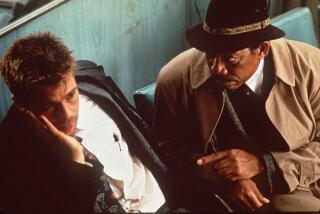A physicist explains ‘Furious 7’
- Share via
Reporting from New York — Matthew Kleban holds a doctorate in physics from Stanford, conducted postdoctorate research at Albert Einstein’s alma mater the Institute for Advanced Study in Princeton, and is now part of the research group at NYU’s Center for Cosmology and Particle Physics.
So as he sat for a media screening of “Furious 7” on a recent weeknight, he had a few thoughts about what was transpiring.
The Vin Diesel-Paul Walker movie contains an abundance of seemingly Newton-defying stunts. Cars drop out of planes at a height of 10,000 feet and go right on rolling along. A man clambers atop a jackknifed bus as it slides off a cliff, beating gravity as he leaps onto a vehicle racing past. A custom-made auto flies between skyscrapers high above Abu Dhabi.
The reaction most viewers have upon watching the movie — after marveling at both the spectacle and Vin Diesel’s command of the English language — is: Could any of this actually happen?
Sitting in the back of the theater, Kleban watched acutely as some of the more eye-popping stunts went down.
In one, the members of Diesel’s strike team backed cars out of an airplane, tumbling between the clouds as they screamed toward the mountain roads of Azerbaijan. Kleban studied the scene as it played, then said after the screening that he didn’t see a physics-based reason why they couldn’t happen as they did on screen.
“You’d need the best equipment, and you’d need everything to go right, like landing in the exact right spot, but there’s no reason a car couldn’t parachute down and keep right on driving,” Kleban said.
The parachute would have to be designed with the highest degree of strength and size (a parachute will slow down a heavy object in direct proportion to the parachute’s area). And of course, the car would still be coming in hard even with an open parachute. But it would be able to “flare up” in the last seconds, converting its high amount of vertical speed to horizontal speed, sufficiently slowing its drop.
(The normal human form of skydiving includes this maneuver too, though people have to be careful not to convert vertical speed into so much horizontal speed they can’t run fast enough to keep up when they land; a car has no such issue.)
In fact, a long pre-parachute freak-out by someone inside the car, as happens in the film, wouldn’t even be likely, Kleban added, because after a number of seconds of free fall the car would reach its terminal velocity of between 200 and 300 miles per hour — and feel to the person inside as if they were not moving at all.
Why a few characters in the movie appeared to be spinning their steering wheel, however, was a mystery, he said; turning tires that aren’t in contact with the ground has no effect. “That didn’t really make sense,” he said, his eyes betraying skepticism.
A slight man with a serious demeanor but a sly sense of humor, Kleban spends his days exploring the mysteries of the universe at both the smallest levels — string theory and the like — and the largest (he studies cosmic bubbles, which among other things draws connections between ancient cosmic collisions and the possibility of multiple universes).
While acknowledging that “Furious 7” was a Hollywood movie and actual plausibility was thus perhaps somewhat beside the point, Kleban also (prodded by a reporter) said there was some value in knowing if these stunts could happen in real life, even if only under optimal conditions and long odds.
Such ambitions are supported by the stance of the filmmakers — director James Wan, producer Neal Moritz, and stunt coordinator Joel Kramer — who take pride in the movie’s practical effects, as well as the fact that, unlike many Hollywood tent poles, their movie takes place in the real world, albeit one with significantly more machine guns and global vendettas.
Other scenes played out on screen as Kleban maintained a close eye. The climactic moment of the Azerbaijan sequence — Walker’s Brian O’Conner running atop the bus — would certainly be possible under the right conditions, Kleban said, since the bus could be sliding more slowly than a person could run. The snag comes at the end of that scene, when O’Conner launches himself off the top of the bus and up and over the cliff, almost flying upward.
“That didn’t really look right,” Kleban said. “He probably shouldn’t be able to get much of a vertical jump at all relative to the cliff with the bus sliding off it.”
A bit later he watched Diesel’s Dom Toretto accelerate through a ballroom in a Lykan HyperSort high above Abu Dhabi — ignoring a passenger-seat warning from Paul Walker’s Brian O’Conner that “cars don’t fly.” As the scene unfolded, Kleban leaned over in his chair and said “I can make some calculations to test that.”
He then seemed slightly troubled, and back in his office the next day, with the help of some pen and paper, came to understand why. In the stunt sequence, Dom drives the Lykan around a ballroom and through a window dozens of stories in the air, crashing through the window of the next building, then careening over some fine art, launching the car back out another window and into the air again and landing in a third building. (And you thought your last flight was bumpy.)
Even a multimillion-dollar vehicle, Kleban noted, would likely be traveling no faster than 60 mph when it crashed out of the first window (all cars take at least about three seconds to get to that speed, by which point it would run out of floor; a car would need a track, not a ballroom, to crank up further).
And a vehicle traveling at 60 mph through the air would need about a second to bridge the gap of roughly 100 feet between the (well-documented ) first two Abu Dhabi buildings — an unfortunately long time frame in which, Kleban calculated, the car would also be plummeting vertically to the tune of about 17 feet.
“And if you a drop any car from a height of 17 feet, it would be a very big shock to the car,” he said. (Things would be exacerbated by the vehicle rotating forward about thirty degrees, meaning it would crash through the window 17 feet below where it started at a sharp, fender-first angle.)
In a hypothetical Earth where vertical velocity didn’t exist, the car could, he noted, survive as it entered the second building, and be able to pick up enough speed there so that it could get up to about 80 or 90 mph for its Boeing-like voyage between the second and third buildings. That would ensure it would be airborne for a manageable half second. Only now there would be another problem.
In the scene, Dom jumps out of the car at the last instant and slides right up to the ledge without going over (the car does). But Dom is of course going as fast as the car when he leaps out, and even if said vehicle had somehow managed to slow down to 40 mph as it slid across the floor in the third building (it couldn’t slow down much more in the allotted space), that meant Dom, too, was moving that fast when he jumped out. And humans, even humans with the box-office drawing power of Vin Diesel, cannot stop on a dime while hurtling across a floor at 40 miles per hour.
Still, Kleban remained impressed. At least the car’s flight between the second and third buildings was possible. And with more room to speed up, the Lykan could even make the jump from the first to the second building, if only the Emiratis had taken a look at the top of a skyscraper and decided to build Daytona there instead of a swanky club.
Paradoxically, it was one of the more earthbound stunts that made Kleban the most skeptical — one that happens right on the streets of downtown L.A.
The scientist was visibly leery, shaking his head and dropping his hands, as he watched a climactic car chase in which two vehicles driven at high speeds by members of Dom’s team converge from different directions on the same intersection, then doughnut around in such a way that they actually are able to pass a team member from the window of one car to the next.
“Yeah, that couldn’t happen,” Kleban said after the screening ended. Basically, he said, a car couldn’t be thrown into a spin as it approached an intersection without the forward momentum carrying it dozens or hundreds of feet in the direction it was already going, while the other car did the same in the other direction. The vehicles would end up spinning as much as a block apart.
“Which,” he added wryly, “would make passing someone through the window a little difficult.”
But Kleban paused a moment later as he took it all in.
For all the inherent absurdity of a Hollywood popcorn picture — and despite Kleban’s empirically based skepticism — he said that he thought “Furious 7” acquitted itself rather well.
“A lot of these issues don’t seem that problematic in the end,” he said. “If you just had the buildings a little closer together, or didn’t have the car going over a ledge while the driver stops himself, a lot of this could actually happen.”
Aware that this ran counter to many viewers’ gut instincts, he continued.
“I think if you’re watching it it doesn’t seem possible, but one of the things about science is that it’s amazing how bad our intuitions are about what’s possible. We have a tendency to believe we know what’s possible, but our intuition is based on our experience, and we don’t have a lot of experience with cars falling out of airplanes.”
He said that physics and its equations offered concrete chalkboard proof to supplement and counter that experience.
Well, the basic form of it, anyway. Kleban’s own specialized study, in realms like black hole singularities and cosmological constants, was unlikely to pay dividends with understanding the film franchise — at least so far.
“Maybe ‘Furious 8,’” he said, “would be Vin Diesel in the multiverse.”
Twitter @ZeitchikLAT
More to Read
Only good movies
Get the Indie Focus newsletter, Mark Olsen's weekly guide to the world of cinema.
You may occasionally receive promotional content from the Los Angeles Times.










